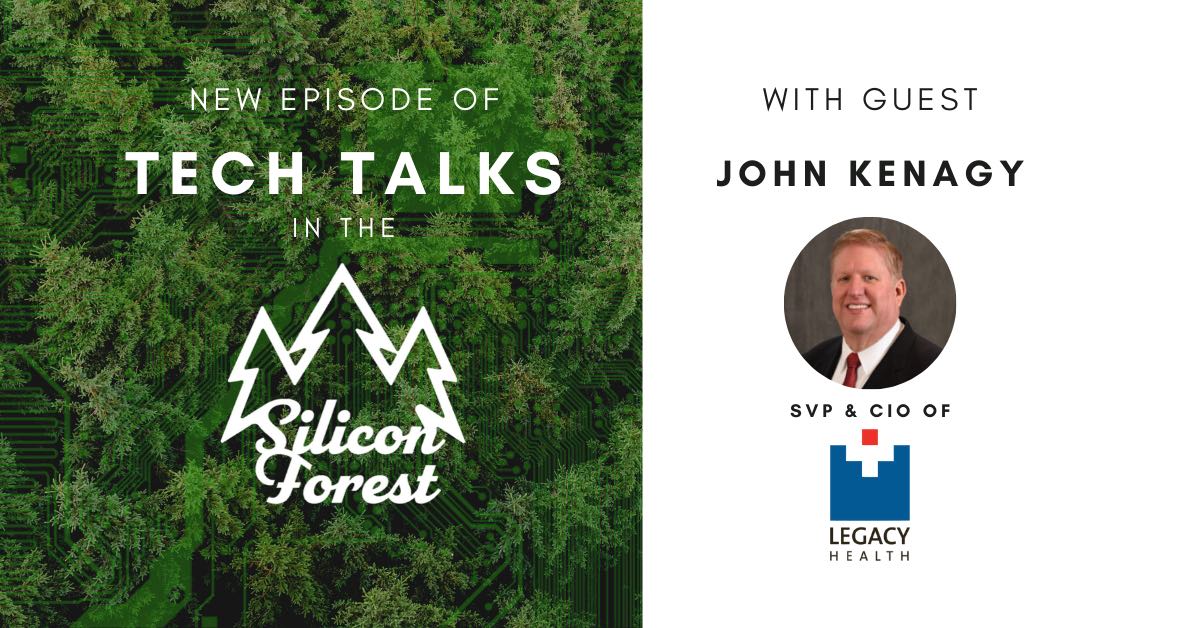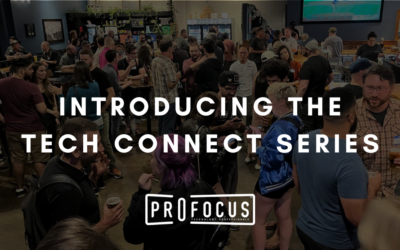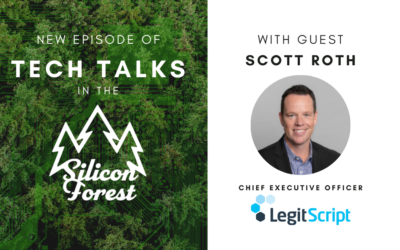On this episode of Tech Talks in the Silicon Forest, host John Boone interviews John Kenagy, the SVP and CIO of Legacy Health here in Portland, Oregon.
From Desktop Support to CIO John Kenagy shares his journey of demystifying tech in the healthcare industry. In this discussion, Kenagy also talks about Legacy Health’s technology response to COVID, what it’s like to be CIO, how the CIO job has changed over time, and what we can expect in the future.
To start off the episode, host John Boone, welcomes Kenagy and introduces us to his impressive 23-years of leadership experience in the healthcare industry. Kenagy worked his way up from desktop support to CIO at the Department of Veterans Affairs. He served as the VP and CIO at Providence Health and Services, the CIO at OHSU, and he’s currently the SVP and CIO of Legacy Health.
Listen here:
BACKGROUND
Over 33 years ago, when Kenagy started as an IT technician he did not anticipate his career would lead him to become the CIO of a large hospital system. He jokes that he, “was happy just having one satisfied user at a time.” In 1987, many users, particularly in the federal government, were skeptical and somewhat afraid of desktop computers. Kenagy reflects fondly on that time in his career and proudly wears his IT support shirt on casual days. Demystifying tech for users and stakeholders soon became a passion for Kenagy that fueled his career.
With most of his experience in the healthcare field, Kenagy’s attitude towards helping others and problem-solving skills often make him feel like “a hero, in an organization that has heroes saving lives. And so that’s been sort of double inspiring.”
Kenagy earned his BS in Electrical Engineering from Stanford, his Ph.D. in IT Management from USC, his Masters of Health Administration from Capella University, and is currently close to completing his Doctor of Law degree at Lewis & Clark University. He recognizes that this level of academic pursuit, “is not necessary to become a CIO. I’m a unicorn in that.”
He goes on to say, “I am the product of two educators. My dad had his Doctorate in education. And my mom had a Master’s in education and teaching a master’s equivalent. And so I grew up with that. My mom was actually the first of her generation in her family to go to college and went all the way to get a master’s degree. So education was just part of who I was growing up. You know, how I was raised.” His education helped him marry the practice of working and the theory.
COVID RESPONSE
With his organization literally on the front lines of the pandemic, Kenagy says that the teams at Legacy Health worked quickly to adapt and plan while monitoring hospitalizations using Power BI statistics. Legacy’s multifold approach considered frontline workers like doctors and nurses as well as ensuring their administrative staff could continue to effectively support business operations such as scheduling, billing, and more.
A few years ago, Legacy faced a similar need for remote work when the Portland metro area was hit with a snowstorm that shut down much of the city’s transportation. Kenagy praised the IT Department’s quick response and ability to scale its remote operations. Over the following 18 months, Legacy adopted Microsoft 365 tools and Azure Cloud, while ensuring their Citrix form was robust enough for thousands of employees to work remotely. These challenges made it possible for Legacy to adapt to stay at home orders and keep their employees and customers safe. Kenagy says he’s often reminded in tech that “necessity is the mother of invention.”
TELEHEALTH
As the pandemic became a prominent threat in the U.S., Kenagy says that Legacy saw a significant decrease in people seeking healthcare, even for serious health issues such as strokes and heart attacks. Telehealth at Legacy created a lifeline for patients and clinicians in a crucial time. Before the pandemic, Legacy had “just under 50 visits, 50 telehealth visits. Yesterday, we had 745 in one day,” said Kenagy.
As Kenagy reflects on the pandemic response and looks towards the future he stresses the importance of access and technology in medicine. He believes healthcare “is emulating or connected to what’s going on in all industries.”
OREGON SPIRIT
Kenagy admires Oregon’s innovative spirit and enjoys working with local vendors to provide essential tools and technologies. From the monitors that allow imaging professionals or radiologists to diagnose illness to the home monitoring systems, Legacy aims to provide reliable and innovative tools for their teams. John goes on to say, “that spirit, is just who we are. And what we try to tap here at Legacy. But I think what you know, your listeners know, what we all are a part of here.”
This attitude towards listening and learning helped Kenagy earn Microsoft’s Trailblazer Award. Kenagy was recognized for his work leading the update for Legacy’s electronic health record and helping implement a disaster recovery basis with Azure. With Legacy’s data center in an area known for the 500-year earthquake fault line, Kenagy’s department also assisted in ensuring geodiversity.
DEVELOPING TALENT WITHIN
John’s advice for IT leaders looking to inspire innovation on their team or in their company? Acknowledge that leaders such as CIOs often create barriers to innovation based on risk aversion and budget, then challenge your team to prove you wrong. These challenges and opportunities to problem solve are ways Kenagy invests in his IT employees.
He says, “people love the experience, you know, healthcare does not pay. We look at the market for a system engineer or a business analyst, and we pay at the market price. That is our policy at Legacy. But, if you really want to get into it and make a lot of money, you wouldn’t come into nonprofit healthcare. And so, I have to have other ways to attract and retain good talent. Getting them working on a hard problem to solve is exciting. People want to make a difference.”
THE FUTURE OF IT
Kenagy sees the adoption of cloud technologies creating fear among some IT staff. He says, “there’s a lot of fear instantly in the rank and file of your IT staff, that you’re just going to eliminate their positions.” Kenagy believes that leaders must acknowledge the concern upfront and clarify that “we’re actually future-proofing your career by having you involved in this.” He constantly reminds his department and other leaders that Legacy is “cloud-first, not cloud-only.” He hopes in the years to come, technology and innovation could help facilitate things like supply management and ordering for nurses or staff and patient matching requirements.
Right before the pandemic halted many communities and businesses, Kenagy began the request and proposal process for a next-generation ERP. This was recently put on hold when he says Legacy saw a “drop of 30% of our volume.” Kenagy says, “we have experienced, in a consolidated system like Epic, that really does a whole suite of services, that we’re missing that on our administrative side.” During enterprise resource planning, he often helps others understand the importance of IT in the healthcare system even though it may not be the company’s main purpose. Kenagy says healthcare is “empowered by the infrastructure of paying our payroll and paying our bills and all the things in the ERP system does.”
THE FUTURE OF CIOS
Kenagy goes on to the discuss the future of the CIO role, encouraging people to aspire to that professional goal. “I love it. The most important thing that I do is listen to what’s going on and strategically listen to the issues,” he says. To get there Kenagy suggests you ask questions throughout your experience like:
- What are the problems we’re trying to solve?
- How do we make a difference here?
- How can we fix that?
- What tools, technologies, people, and processes involved in this result?
- How can you build solutions together?
As CIO, Kenagy plays a key role in helping different teams and even departments collaborate to solve issues. He thinks one of the big roles of CIO is playing the translator between business and IT. In meetings, his role is to make sure that IT doesn’t seem too exclusive and remind people that technology can be used to help solve other business issues. He acknowledges that CIOs must understand when to bring in IT managers, designers, developers, and other technologists to the conversation. He says, “I think my role is demystifying technology. I think the key to being a CIO is not your technology chops. It’s your being able to translate a technology mindset into what the business needs.”
A PLACE FOR EVERYONE
Kenagy’s 23-years of leadership in the healthcare industry taught him that successful IT leaders listen. They listen to different ideas, solutions, problems, and failures. Kenagy strongly believes that although IT has a reputation for attracting introverts, successful IT leaders find their voice from listening and helping others. When his team’s responsibility is to make sure everyone else can do their job and it gives them purpose and confidence. He says that at times “we wear our hero cape,” but most often we listen and work behind the scenes.
AN INCLUSIVE CULTURE IS ESSENTIAL FOR HEALTHCARE
As a leader in the technology and healthcare fields, Kenagy recognizes the importance of listening as a tool for creating inclusivity and promoting diversity. He encourages his team to disagree with him and is suspicious of leaders that surround themselves with ‘yes people’. “I think part of the leader’s culture is how do you deal with disconfirming or different opinions,” says Kenagy. He believes different opinions come from “different life experiences.”
He says, “in our department, we have folks that are nurses, pharmacists, doctors, and IT professionals. We have people who have been here for 30 years, and people who have been here for 30 days. We have men, women, diversity of all backstories, and walks of life.”
To help build a culture where everyone can feel comfortable disagreeing or raising concerns, Kenagy starts at the top. “I just talked at our town hall meeting with all the staff,” says Kenagy, “I said, you know, let me acknowledge that I’m afraid of saying the wrong thing when it comes to race. I’m 57 years old, I’ve been in the workforce for 33 years, race, religion, and politics were sort of taboo to talk about in the workplace.” To set an example for his team, Kenagy tries to always acknowledge his discomfort and encourage others to do the same in order to make progress. “I don’t want my fear to say the wrong thing to become my silence,” he says.
IT LEADERSHIP
As Kenagy reflects on his path to and through leadership, he imagines a future where a CIO comes from an operations or business development background. The building blocks of technology like product management, needs assessment, vendor management, and various others have shifted over the last couple of decades. Kenagy says widespread access to technology has led to the “democratization of IT, where everybody is their own CIO at home, in their personal life or in their pocket.” He believes his successors in future CIO or hybrid roles will face major changes in telehealth and accessibility.
THANK YOU
John Kenagy’s journey in IT leadership helps us better understand the professional strengths needed to facilitate innovation and progress in technology and healthcare. He encourages fellow and aspiring IT leaders to connect with him on LinkedIn and continue the conversation of what IT leadership looks like within your own organizations.
For more insights, check out the full interview on Tech Talks in the Silicon Forest with host John Boone, President, and Founder of ProFocus Technology. ProFocus is an award-winning technology staffing and consulting firm in Portland, Oregon.
If you or someone you know might be interested in joining the podcast and sharing their story please email [email protected].




